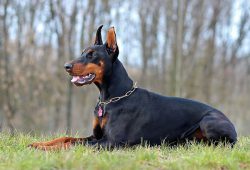The Doberman Pinscher, or Dobermann, or Doberman, is a medium-large breed of domestic dog originally developed around 1890 by Karl Friedrich Louis Dobermann, a tax collector from [wiki base=”EN”]Germany[/wiki]. The Doberman has a long muzzle and stands on its toes (not the pads) and is not usually heavy-footed. Ideally, they have an even and graceful gait. Traditionally, the ears are cropped and posted, and the tail is docked. However, in some countries it is illegal to do so. Dobermans have markings on the chest, paws/legs, muzzle, above the eyes, and underneath the tail.
Doberman Pinschers are well known as intelligent, alert, and tenaciously loyal companions and guard dogs. Personality varies a great deal between each individual, but if taken care of and trained properly they tend to be loving and devoted companions. The Doberman is driven, strong, and sometimes stubborn. Owning one requires commitment and care, but if trained well, they can be wonderful family dogs. With a consistent approach they can be easy to train and will learn very quickly. As with all dogs, if properly trained, they can be excellent with children.
Temperament
Although they are considered to be working dogs, Doberman Pinschers are often stereotyped as being ferocious and aggressive. As a personal protection dog, the Doberman was originally bred for these traits: it had to be large and intimidating, fearless, and willing to defend its owner, but sufficiently obedient and restrained to only do so on command. These traits served the dog well in its role as a personal defense dog, police dog, or war dog, but were not ideally adapted to a companionship role. The Doberman Pinscher’s aggression has been toned down by modern breeders over the years, and today’s Dobermans are known for a much more even and good natured temperament, extreme loyalty, high intelligence, and great trainability. In fact, the Doberman Pinscher’s size, short coat, and intelligence have made it a desirable house dog. The Doberman Pinscher is known to be energetic, watchful, fearless and obedient.
They can easily learn to ‘Respect and Protect’ their owners, and are therefore considered to be excellent guard dogs that protect their loved ones. They are generally sociable toward humans and can be with other dogs. However, Dobermans rank among the more-likely breeds to show aggressive behaviour toward strangers and other dogs, but not among the most likely to do so. They are very unlikely to show aggressive behaviour toward their owners.
Health
The Doberman’s lifespan is about 10–11 years, on average. They may suffer from a number of health concerns. Common serious health problems include [wiki title=”Dilated_cardiomyopathy” base=”EN”]dilated cardiomyopathy[/wiki], [wiki title=”Wobbler_disease” base=”EN”]cervical vertebral instability[/wiki] (CVI), [wiki title=”Von_Willebrand_disease” base=”EN”]von Willebrand’s disease[/wiki] (a bleeding disorder for which genetic testing has been available since 2000; the test enables both parents of a prospective litter to be tested for the carrier gene, thus preventing inheritance of the disease ), and prostatic disease. Less serious common health concerns include [wiki title=”Hypothyroidism” base=”EN”]hypothyroidism[/wiki] and [wiki title=”Hip_dysplasia_(canine)” base=”EN”]hip dysplasia[/wiki]. Canine compulsive disorder is also common. Studies have shown that the Doberman Pinscher suffers from prostatic diseases, (such as bacterial prostatiti, prostatic cysts, prostatic adenocarcinoma, and benign hyperplasia) more than any other breed. Neutering can significantly reduce these risks.
Doberman Pinscher. (2017, July 19). In Wikipedia, The Free Encyclopedia. Retrieved from https://en.wikipedia.org/w/index.php?title=Doberman_Pinscher&oldid=791258432


